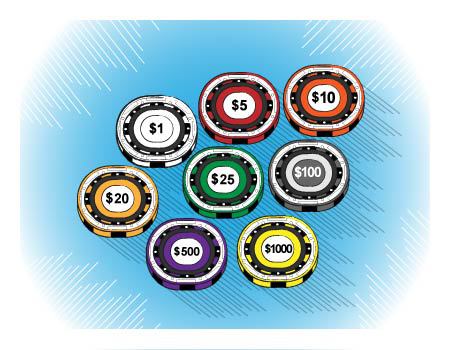7/10/2022
How Many Chips Do You Need To Play Poker
How Many Chips Do You Need To Play Poker 6,4/10 3641 reviews


Cash-style games require about 40 chips on hand for each player. For example, to comfortably host a typical $1-$2 no-limit Texas Hold 'em game with $200 buy-ins for ten players, you'll need: - One hundred $1 chips (white) - Two hundred $5 chips (red). I wouldn't recommend getting less than 500 chips as they aren't that expensive and it's a pain to be making change all through the game. 300 chip set 500 chip set. If there are six chips in the pot, and a bet of four is made, the total is 10 chips; it requires four chips for the next player to call, making 14; and the player may then raise by 14 chips. But even when the pot limit is played, there should be some maximum limit, such as 50 chips.



How Many Chips Do You Need To Play Pokerstars
There is no official regulation regarding the chips in a poker set and that is why many people wonder how many chips and also what breakdown to use. Every choice you make will affect the tournament levels’ duration, the time to make a move and others. If it is your first time to buy chips, you may want to choose a set in a case. The set may include 300, 500 or 750 chips, two decks of playing cards, big blind, little blind, and dealer buttons. In this article we will take a look at several possible variations, depending on the poker game you will play.
According to the number of players, the chips‘ count will vary. For up to 6 players you will need 300 poker chips; for up to 10 players — 500 chips. And for a tournament with over 10 players, it is advisable to use at least 1000 poker chips. If you need to set ranges for chips per player, consider at least 50 to 100 chips per player. However, it is also a matter of playing style — if you prefer to give players a big pile of chips, you may also need more than 1000 chips.
When choosing the values in the set, ensure that each value is 4 to 5 times higher than the previous one. In this regard, it may be better not to include chips valued 2, but to use for instance the following values: 1, 5, 25, 100. Again the question arises regarding how much from each value to pick up. Let us use the above example with up to 10 players and 500 poker chips and the chips’ values, respectively 1, 5, 25, 100. According to the statistics, the most used values are ranked as follows: 5-1-25-100, therefore the distribution will be 200-150-100-20.
Another detail to consider is the pot-limit of the game you are organising. It matters if you are planning a cash game, a no-limit Texas Hold’em tournament or a pot-limit tournament. In addition, consider also the blind value — big blinds and little blinds. The above-explained values are a good starting point for the blinds, as well. Before buying any poker chips, consider what will be the lowest denomination chip, for instance, $1, $2 or $5. In addition, the higher the buy-in the more chips are required.
If you will be using the chips at home to play multiple games, consider at least 80 to 100 chips per person and also a variety of colours/denominations. Depending on the players and the type of the game (blackjack, poker, etc) the chips you will need will vary. If the players will be up to 3 consider 300-400 chips; for 4 players — around 500 chips. For 6 players — 600 chips and for up to 10 players, respectively 800-1000 chips.
All the examples above are for tournaments up to 10 players. In case you are planning to make a home tournament with more players and you want the game duration to be longer (or dynamic and shorter), you may check poker chip calculators. Poker chip calculators are helpful and advise on how many chips to use depending on some variables. For example the type of game (tournament or a cash game), the number of players, re-buys (if any), blind levels and other variables. You could also determine the tournament length and the duration of each level.
In case the type of game you are planning to host is a cash game, choose the table stakes first. If the stakes will be lower, you will need more low valued chips. In addition, you can also define that each chip (no matter the colour) will be worth $1 and if players will be able to re-buy, you may need a set of 1000 chips.
To sum up, the poker chips’ count in a set varies and it is also possible to buy extra chips if needed. Before you choose a poker case, you need to consider the following: number of players, the type of the game, the duration, with or without re-buys. Also, define the amount of the buy-in, the rewards, the tournament levels (if it is a tournament). But above all, it is important to have a nice time, especially when you are playing with friends.
According to the number of players, the chips‘ count will vary. For up to 6 players you will need 300 poker chips; for up to 10 players — 500 chips. And for a tournament with over 10 players, it is advisable to use at least 1000 poker chips. If you need to set ranges for chips per player, consider at least 50 to 100 chips per player. However, it is also a matter of playing style — if you prefer to give players a big pile of chips, you may also need more than 1000 chips.
When choosing the values in the set, ensure that each value is 4 to 5 times higher than the previous one. In this regard, it may be better not to include chips valued 2, but to use for instance the following values: 1, 5, 25, 100. Again the question arises regarding how much from each value to pick up. Let us use the above example with up to 10 players and 500 poker chips and the chips’ values, respectively 1, 5, 25, 100. According to the statistics, the most used values are ranked as follows: 5-1-25-100, therefore the distribution will be 200-150-100-20.
Another detail to consider is the pot-limit of the game you are organising. It matters if you are planning a cash game, a no-limit Texas Hold’em tournament or a pot-limit tournament. In addition, consider also the blind value — big blinds and little blinds. The above-explained values are a good starting point for the blinds, as well. Before buying any poker chips, consider what will be the lowest denomination chip, for instance, $1, $2 or $5. In addition, the higher the buy-in the more chips are required.
If you will be using the chips at home to play multiple games, consider at least 80 to 100 chips per person and also a variety of colours/denominations. Depending on the players and the type of the game (blackjack, poker, etc) the chips you will need will vary. If the players will be up to 3 consider 300-400 chips; for 4 players — around 500 chips. For 6 players — 600 chips and for up to 10 players, respectively 800-1000 chips.
All the examples above are for tournaments up to 10 players. In case you are planning to make a home tournament with more players and you want the game duration to be longer (or dynamic and shorter), you may check poker chip calculators. Poker chip calculators are helpful and advise on how many chips to use depending on some variables. For example the type of game (tournament or a cash game), the number of players, re-buys (if any), blind levels and other variables. You could also determine the tournament length and the duration of each level.
In case the type of game you are planning to host is a cash game, choose the table stakes first. If the stakes will be lower, you will need more low valued chips. In addition, you can also define that each chip (no matter the colour) will be worth $1 and if players will be able to re-buy, you may need a set of 1000 chips.
To sum up, the poker chips’ count in a set varies and it is also possible to buy extra chips if needed. Before you choose a poker case, you need to consider the following: number of players, the type of the game, the duration, with or without re-buys. Also, define the amount of the buy-in, the rewards, the tournament levels (if it is a tournament). But above all, it is important to have a nice time, especially when you are playing with friends.